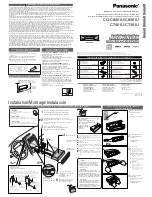
H0 Sound Decoder MX640 Page 37
8. Installation and wiring of the MX640
General information:
There has to be enough
free space inside the engine
so that the decoder can freely be mounted.
Pay particular attention that no pressure is exerted on the decoder when the loco housing is being
reinstalled and that no movable parts can contact the decoder or wires.
All direct connections that are present in the original wiring configuration between the power pick-
ups (wheels and wipers) and the motor
must be separated
; otherwise the decoder end stage may
get damaged at power-up.
The same goes for the headlights and other additional accessories. They must be
completely iso-
lated.
Do noise suppression components on a locomotive motor have
a negative affect on motor regulation?
Yes, sometimes . . .
Explanation: Motors of model railroad locomotives are often equipped with choke coils and capaci-
tors, which are supposed to suppress or filter out noise (poor TV reception etc.) caused by the
sparks arcing across the motor’s brushes.
Such components impair the motor regulation. Although ZIMO decoders manage quite well, that is
there is hardly a difference in performance with or without those components in place. However, in
recent years larger choke coils are being installed in many locomotives than was the case earlier –
and these can noticeably compromise drivability.
The potentially “harmful” choke coils are often recognizable by their shape of a resistor with color
bands (in contrast to a wire wound ferrite bar). That doesn’t mean though that these choke coils
have a negative effect in all cases.
Fleischmann locomotives
with
“Round motors”
(an older motor design) often have extremely bad
filter components;
especially dangerous are those capacitors that connect between the motor
connections and the frame, which can even lead to the destruction of the decoder end stage!
These components are often hard to see and to get at.
Indications of an actual negative effect of such components, besides a general unsatisfactory motor
control (jerking…), are:
- weak control compensation: as a test, set the decoder to low frequency – CV #9 = 200 – and check
to see whether the control compensation becomes stronger. If that’s the case, the choke coils are
most likely to blame for the weak compensation in the high frequency range.
- if a difference in compensation is noticeable between 20 and 40 kHz (select in CV #112, Bit 5); if
the compensation (further) diminishes at 40 kHz, it is very possible that the choke coils or capacitors
are the cause.
Remedy:
Bypass
(or remove)
choke coils,
remove capacitors!
Capacitors are less likely to inter-
fere with motor regulations but cannot be ruled out especially for the Fleischmann “Round motor”,
see above.
PLEASE NOTE: Body mounted light bulbs that are hard to insulate can be left as is. The body acts
as the power supply to the bulb. The blue lead from the decoder must not be connected to the bulbs
in such circumstances. The white and yellow leads are connected to the other side of the bulbs. The
brightness of the headlights will be reduced in such an application.
SPECIAL CASES of locomotives with AC motors:
Two additional 1N4007 diodes (or equivalent, for at least 1A) are required as shown in the diagram
below. They can be obtained at your local electronic store or from ZIMO at minimal cost.
Red
Black
Orange
Blue
Yellow
White
Gray
Right rail
Left rail
M
Headlights
Rear Front
AC-m otor
Field coils
2 Diodes 1N4007
Rotor
Most locomotives that run with an AC motor get the power supplied by a third rail, which doesn’t
change anything as far as the motor hook-up is concerned. The above schematic is therefore valid
for AC locomotives running on two or three rail track.








































